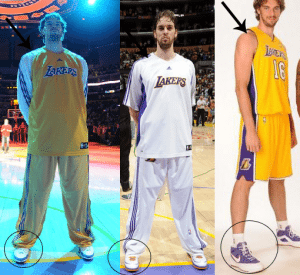
Pau Gasau of the LA Lakers has plantar fasciitis. Here is what the experts may be missing.
Plantar fasciitis is a condition that can cause debilitating pain in the feet. Athletes and nonathletes as well have experienced this condition however, there are different schools of thought. Most healthcare providers learned in school to evaluate the problem, name it, in this case, plantar fasciitis and then rest, stretch the feet and calves, and even recommend foot orthotics. What most doctors often do not do is look past the feet. As in our previous study with Tiger Woods, according to the book Cheating Mother Nature, what you need to know to beat chronic pain, plantar fasciitis is a symptom of a larger problem. The way we walk determines the way we function and the way we often feel.
Our gait (the way we walk) is inherited as well as our body style (the way we are shaped). Taking this into account, especially since I am sure they will want him back in his full glory, to properly diagnose him, we must look past his feet. You will notice in the photo collage above that in all photos, his right foot turns out. You will also notice that in all photos, his right shoulder rolls in more than his left. These are family traits, which will predispose him to have problems in his core muscles. When the foot turns out as discussed in Cheating Mother Nature, the hip on that side drops. This creates uneven loading on the body leading to under striding on that side (in his case, the right side). The other side will under stride. While this does not seem like a big problem, it will cause the myofascia (the connective tissue surrounding his core) to distort his hips, lock up his mid-back and he will develop a hard heel strike. The legs will in turn tighten since he is no longer using his core properly since it should carry more of the forces from walking, running, and jumping and so will the calves. This, combined with the decreased shock absorption in the calves will cause the plantar fascia (the tissues on the bottom of the feet) to become less flexible and brittle and develop micro-tears with each game he plays, resulting in foot pain in the mornings. Read more about Plantar Fasciitis here.
As discussed in the NBA news release, the performed an MRI likely to rule out a stress fracture and did not look at any part other than his feet. It is quite likely, their therapeutic approach has included ultrasound to the feet, maybe calf stretches and even a night boot to stretch the calf if not an injection at the site of pain. Most health care providers consider these regimens appropriate.
Thinking about his problem from a larger perspective, since includes how he walks, and the fact that he is slamming his feet into the ground, shouldn’t our approach take into account the fact he is constantly reinjuring the area when he walks and runs, shouldn’t treatment be geared toward improving the way his body works, how his core works, and why his legs are tight? While this seems to make sense, most doctors are taught to look at where it hurts and not why.
How to fix Pau Gasau and relieve his plantar fasciitis as well as the other conditions he is prone to.
1. Foot orthotics to improve his symmetry on and off the court. It will pay dividends, prevent future episodes of pain, and improve his shot too since it levels out the pelvis.
2. Fascial Release to the core muscles, and secondarily to the legs.
3. Fascial release to the plantar fascia, with chiropractic manipulation to the feet, ankles, hips, and pelvis to improve the way these joints move. If the foot is stiff, and the bones in the kinetic chains (the foot, hip and knee are a kinetic chain), it will lead to other symptoms, bad knees, and hip issues as well as lower back pain, a problem he also likely deals with. Prior to his problem with plantar fasciitis, his knees were indeed aching.
4. Core strengthening and balance regimens. While he is back playing now, it is quite likely the next problem will appear if the true problems he has (his gait) are not properly addressed. The plantar fasciitis and knee pain are merely secondary issues.